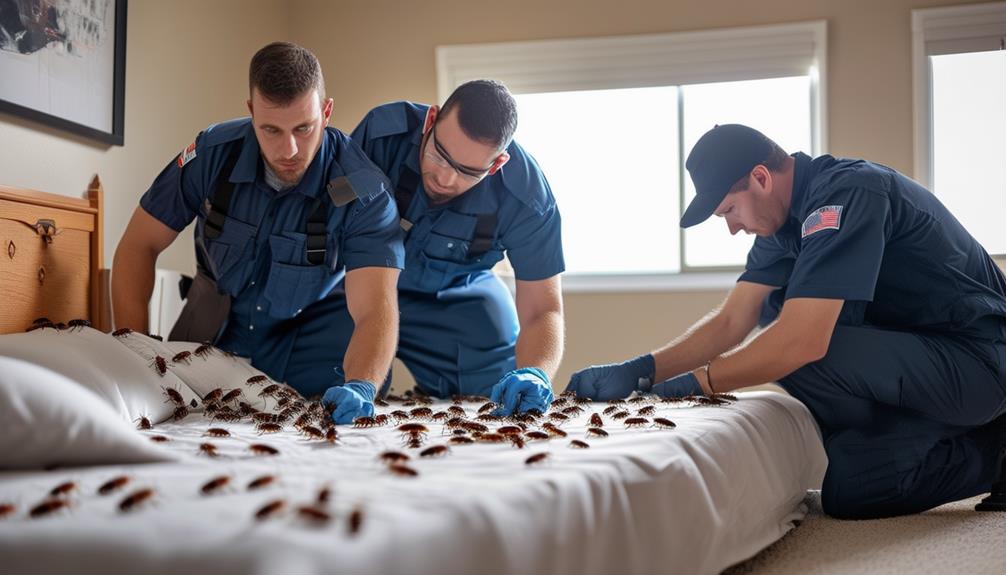Imagine a serene classroom, filled with eager students and the soft hum of learning. But amidst this idyllic scene, there lurks a hidden threat – ants.
These tiny creatures, with their relentless determination and insatiable appetites, can disrupt the tranquility of a school environment. From contaminating food to carrying harmful bacteria, ants pose a serious risk to the health and safety of students and staff.
So, how can schools effectively control and prevent ant infestations to create a truly safe learning environment? Let’s explore the strategies and techniques that can help keep these unwelcome guests at bay.
Key Takeaways
- Regular inspection and identification of ant entry points is crucial for effective ant control in schools.
- Implementing Integrated Pest Management (IPM) strategies and using least toxic pest control methods are recommended for ant control.
- Habitat modification, regular cleaning of food preparation areas, and storing food in ant-proof containers can help prevent ant infestations.
- Regular monitoring and prompt action, such as sealing entry points and using appropriate pesticides if necessary, are essential for successful ant management in schools.
Common Entry Points for Ants
Ants can enter schools through various entry points such as tiny cracks and gaps in walls, windows, and doors. They may also find their way in through utility lines, pipes, and electrical wiring. Landscaping elements like mulch, tree branches, and overgrown vegetation can provide pathways for ants to enter buildings.
Ants are attracted to food sources, so they can easily come in through open windows, doors, and vents near kitchens and cafeterias. Additionally, trash cans and dumpsters near school buildings can be enticing to ants, providing them with convenient entry points.
It’s crucial to address these common entry points to effectively control ant infestations in school buildings and create a safe learning environment. Monitoring pest populations and implementing Integrated Pest Management (IPM) strategies, which prioritize non-chemical methods, can help in preventing ant invasions and maintaining a pest-free environment for students and staff.
Identifying Ant Infestations
To effectively address ant infestations in schools, it’s essential to accurately identify the presence of these pests through visual inspection and proper understanding of their habits and food preferences.
Here are three key steps to help you identify ant infestations:
-
Visual Inspection: Look for signs of ants, such as ant trails, nests, or piles of soil near the building. Pay attention to areas where food is stored, prepared, or consumed, as ants are attracted to these areas.
-
Proper Understanding of Habits and Food Preferences: Different ant species have different habits and food preferences. For example, fire ants are attracted to greasy or sugary foods, while carpenter ants are drawn to damp or decaying wood. Knowing these preferences can help in identifying the species and implementing appropriate management strategies.
-
Integrated Pest Management: Integrated pest management involves using a combination of strategies to control pests while minimizing risks to human health and the environment. This approach includes habitat modification, sanitation, and the use of least toxic pest control methods.
Preventive Measures for Ant Control
After accurately identifying the presence of ant infestations in schools through visual inspection and understanding their habits and food preferences, it’s crucial to implement preventive measures to control and minimize future ant infestations.
To achieve this, habitat modification should be implemented to reduce ant entryways and access to food. Regularly cleaning school kitchens and food preparation areas is essential to eliminate potential food sources for ants. In classrooms and food preparation areas, a mixture of soap and water can be used to kill ants.
Potential entryways should be caulked with silicone caulk to prevent ants from entering the school. It’s also important to advise students and teachers to store food in ant-proof containers.
By implementing these preventive measures, schools can create a safe learning environment that’s free from ant infestations.
These measures align with the principles of Integrated Pest Management (IPM) program, which focuses on minimizing pesticide use and promoting environmentally friendly practices.
Effective Monitoring Techniques
Regular monitoring techniques are essential for effectively detecting and managing ant infestations in school buildings. To ensure a safe learning environment, it’s important to implement the following monitoring techniques:
-
Conduct visual inspections: Regularly inspect school buildings to identify signs of ant activity, such as foraging trails and nests. Pay close attention to crack and crevice areas where ants tend to hide.
-
Utilize monitoring traps: Place sticky boards in key areas to intercept and monitor ant movement. This will help determine the extent of the infestation and guide control efforts.
-
Involve students and staff: Encourage students and staff to report any signs of ant infestations. Actively involve them in the School IPM (Integrated Pest Management) program to facilitate early intervention and control measures.
Implementing Ant Management Strategies
Implementing ant management strategies in schools involves utilizing a combination of habitat modification, sanitation practices, and integrated pest management techniques.
To control ant infestations, regular cleaning of food service areas is essential. This includes promptly cleaning up spills and crumbs, as well as storing food in ant-proof containers.
Additionally, sealing entry points such as cracks and gaps in walls and floors can help prevent ants from entering the school environment. Integrated pest management practices, recommended by the Department of Agriculture, can reduce the use of pesticides.
However, if non-chemical methods are insufficient, the use of pesticides such as boric acid, diatomaceous earth, and ant baits may be necessary. Proper identification of ants is crucial to tailor the control methods to the specific species.
Frequently Asked Questions
How Do You Get Rid of Ants in School?
To get rid of ants in school, try natural remedies like soap and water mixtures or ant baits. If that doesn’t work, professional exterminators can help. Focus on ant prevention strategies, classroom cleanliness, and educating students. Regular inspections and collaborating with parents are important too.
Can You Use Ants as Pest Control?
You can definitely use ants as a form of natural pest control. Ant colonies have intricate behavior patterns that can be harnessed for sustainable pest management. Integrated pest management strategies and ant repellents are effective methods to control infestations and maintain school hygiene.
What Steps Do You Think Your School Takes to Prevent Pest Problems?
Your school takes several steps to prevent pest problems. They prioritize school cleanliness, conduct regular pest inspections, practice proper waste management, seal entry points, perform regular maintenance checks, use integrated pest management techniques, educate students on prevention, employ non-toxic pest control methods, hire professional exterminators, and collaborate with local pest control agencies.
Is an Ant Infestation a Health Hazard?
An ant infestation can be a health hazard. Ants in food can contaminate it and cause illness. Certain ant species, like fire ants, can cause allergic reactions and bites can lead to infection. It is important to maintain cleanliness and educate students on ant safety to prevent infestations. Professional pest control and natural remedies can also help in controlling ants in schools.




